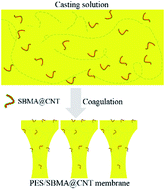Fabrication and characterization of antifouling carbon nanotube/polyethersulfone ultrafiltration membranes†
Abstract
In this study, carbon nanotubes coated with poly(sulfobetaine methacrylate) (SBMA@CNT) particles were synthesized via a precipitation polymerization method. The SBMA@CNT particles were used as a novel kind of modifier to fabricate polyethersulfone (PES) ultrafiltration membranes by a non-solvent induced phase separation method (NIPS). During the membrane formation process, the surface segregation phenomenon of the SBMA@CNT particles was found, which was demonstrated by an energy dispersive spectrometer (EDS) mapping and X-ray photoelectron spectroscopy (XPS). This phenomenon was ascribed to the self-organization of hydrophilic SBMA@CNT particles spontaneously on the interface of membrane/water in the formation of membranes. In the ultrafiltration of a bovine serum albumin (BSA) feed solution, the best-performing membrane was found to effectively reduce protein adhesion. Its irreversible and reversible flux declines were remarkably decreased and the flux recovery was as high as 98.9%.


 Please wait while we load your content...
Please wait while we load your content...